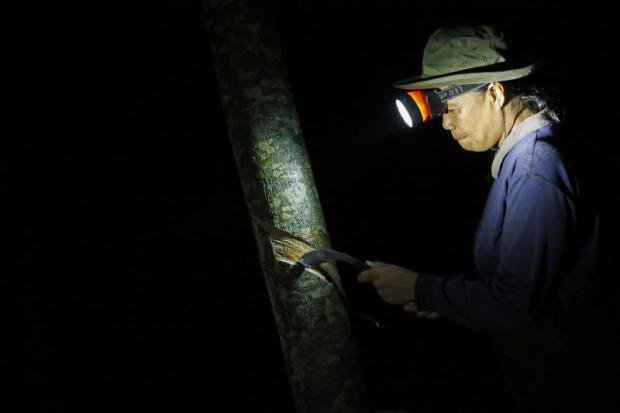The three biggest natural-rubber-producing countries — Thailand, Indonesia and Malaysia — are working on cutting rubber exports in the second half of the year to curb falling prices, according to senior government and industry officials.

A farmer taps latex from a rubber tree at a plantation in the southern province of Nakhon Sri Thammarat. PATIPAT JANTHONG
Titus Suksaard, the governor of the Rubber Authority of Thailand, said senior officials are deciding on the appropriate amount of export cuts and the measure is expected to be adopted soon.
“The International Tripartite Rubber Council (ITRC) is due to meet shortly as the Thai government seeks measures to support prices in the short-term,” Mr Titus said.
He said the three countries have also agreed to move forward the ministerial meeting of the farm ministers of the three countries from December to September this year to seek long-term price-support measures.
Mr Titus declined to give further details on when the export cuts will start and how large they will be, but senior industry officials said it will be in August and the size of cuts will likely be the same as last year — around 300,000 tonnes.
Representatives from the three countries meet several times each year to seek ways to stabilise rubber prices if necessary.
Thailand, Indonesia and Malaysia rank as the top three producers of natural rubber, with annual output of 4.5 million, 3.1 million and 720,000 tonnes, respectively.
Rubber output of the three countries accounts for more than 60% of total global rubber output of about 12 million tonnes a year.
The benchmark export grade of Thai smoked rubber sheet (RSS3) fell 12% from 60.50 baht per kilogramme in the previous year to 53.50 baht currently, sparking concerns among rubber farmers, mostly in Thailand’s southern region, where roughly 65% of the country’s annual output is produced.
The current rubber price is well below the 148 baht per kilogramme seen in 2011, when rubber prices hit a record high due to strong demand at a time when oil prices were surging, pushing the price of synthetic rubber, an alternative to petroleum-based rubber, higher and encouraging global tyre makers to switch to natural rubber.
The recent natural rubber price dip is due largely to an export halt from China, the world’s biggest rubber consumer, in the past few months. China imported a lot of rubber during the first quarter, when prices slumped, leaving millions of tonnes of imported rubber at the port of Qingdao.
Traders said excessive rubber imports earlier this year pushed Chinese rubber stocks as high as 250,000 tonnes, up from the normal rate of 50,000-60,000 tonnes.
Traders view the measure to cut rubber exports as verbal intervention to help push prices up via a short-term psychological impact of the export-cut announcement expected over the coming months.
“Rubber fundamentals remain strong, with seasonal rains in the three countries disrupting tapping and reducing supply, which should support rubber prices over the next few months,” said Luckchai Kittipol, honorary president of the Thai Rubber Association.
Another industry official said the temporary fall in prices was caused by Chinese import disruptions at a time when the liquidation of speculative futures contracts weighs on rubber prices.





























